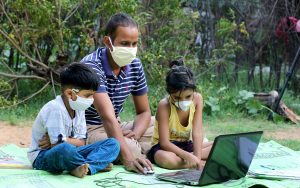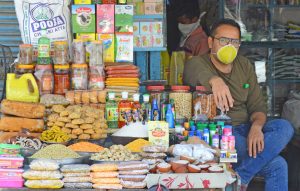How to support students and the learning process during India’s COVID-19 school closures
The long-term social and economic impacts of the COVID-19 pandemic are unknown, but many worry that lockdown-related school closures lasting months will have enduring effects. Anjali Pant, Samuel Scott, Phuong Nguyen draw on survey data on 20,000 adolescents in northern India to estimate the impact of closed schools on educational achievement and how targeted government policies can make a difference.—Johan Swinnen, series co-editor and IFPRI Director General.

Mukesh Kumar Jwala/Shutterstock: A man works on an online lesson with two children in Jaipur, Rajasthan, India. Research shows that close interactive relationships between parents and children during lockdowns can help the learning process and have long-term benefits.
The COVID-19 pandemic has affected 1.6 billion learners worldwide, and school closures could lead to a loss of 0.3-0.9 years of schooling, according to World Bank estimates; a global shutdown of five months could result in lost earnings of $10 trillion over students’ lifetimes. The pandemic’s economic shocks are likely to increase school drop-out rates. Evidence suggests that the poor, girls, and other marginalized groups disproportionately suffer the consequences of school closures.
Given its large population and the poor pre-pandemic state of its education system, India is likely to feel these impacts acutely. The government shut all schools in March. In October, it allowed states to begin reopening some schools, but many remain closed. The lockdown has forced more than 320 million children out of school.
To get insights on this, we studied learning skills among 20,000 adolescents aged 10-19 in India’s two most populated and poor states, Uttar Pradesh and Bihar. Data were taken from the Population Council’s Understanding the Lives of Adolescents and Young Adults (UDAYA) survey from 2015-16. Reading and math proficiency were measured as ability to read at story level (standard 2 level text) and ability to solve at least two subtraction problems, respectively, using the Annual Status of Education Report (ASER) methodology. We found that nearly one in three adolescents could not read age-appropriate text and 30%-42% could not solve basic subtraction problems. In the last decade, the grim state of learning has remained unchanged in these states, despite sustained government efforts in the form of free distribution of uniforms, bicycles, textbooks, and meals, among other things.
COVID-19 is making things worse. Several actions are needed to improve adolescents’ learning, both at home and in school that can support education during school closings—and going forward post-lockdown.
Policy opportunities for enhancing adolescent learning
Most of the factors that we found to be associated with reading and math ability among adolescents can be improved through targeted interventions, including school attendance, wealth, sanitation, communication with parents, and gender attitudes.
The strongest predictor of learning outcomes was attending school, with an added advantage of attending a private over government school. Attending school has multiple benefits: interacting with teachers and peers, accessing free food, and exposure to a structured curriculum. In India, private schools have better teacher accountability and a lower pupil:teacher ratio. Compared to those out of school, adolescents in school were around five (government school) and eight (private school) times more likely to be proficient in reading and math.
With most adolescents now out of school, parents have taken on an increasingly important role in ensuring their well-being. The pandemic has led parents to spend more time with their children; this is an opportunity for parents to foster closer and more open relationships with their adolescent children. In our study, we found that an interactive relationship between the adolescent and her/his parents was predictive of better learning outcomes: those with a high parental support score were about 20% more likely to exhibit age-appropriate reading and math skills compared to those with a low parental support score. Further, those with a gender-equal attitude—i.e., an outlook that boys and girls should be treated the same—were twice as likely to have age-appropriate learning outcomes.
Of course, not all family dynamics have a positive outcome on learning outcomes, and the national lockdown has altered family relations in many households. In several states, cases of domestic violence have increased, which could disrupt adolescents’ ability to learn. In our study, substance abuse by family members, ever witnessing parental violence, and ever experiencing sexual abuse were all predictive of poorer learning outcomes among adolescents. Adolescents with these negative experiences were around 20%-30% less likely to be able to read a story and solve subtraction problems compared to those without these negative experiences.
Being out of school and staying at home under lockdowns therefore may create divergent outcomes for students, with those in supportive family environments building upon their learning and development, and those in households experiencing economic stress, abuse, or domestic violence falling further behind. During school closures and lockdowns, parental attitudes and family relationships are likely to have an even greater impact on students’ learning and social-emotional development.
The way forward
India’s recently launched New Education Policy 2020 (NEP 2020) acknowledges the urgent need to strengthen foundational learning skills in India. The policy aims to reduce school dropout rates through infrastructure support and constant learning evaluation, engage parents to promote children’s development, integrate essential capacities such as gender sensitivity, promote inclusive and equitable education, and build synergy across private and public schools.
While some schools have reopened, e-learning may be the preferred mode of learning for many adolescents in the coming months. NEP 2020 promotes the extensive use of technology in education but does not account for the substantial inequity that exists in access to technology, especially in rural areas. Given the digital divide and the dismal learning situation in India, an immediate policy priority should be to make online learning more inclusive and tailored to avoid further setbacks among adolescents with limited connectivity.
To achieve better adolescent learning outcomes in the medium to long term, our findings from Uttar Pradesh and Bihar suggest that, other than ensuring adolescents enroll and stay in school, policies should broadly aim to build household wealth and strengthen family support systems. Parents can help their children learn at home by having open conversations and building an environment that promotes social-emotional well-being, among other strategies recently recommended by UNICEF. Digital parenting resources may play an important role, though limited accessibility in remote areas remains a challenge. Schools should also strive to include parents in their children’s learning experience once students are back in person.
Within the next decade, today’s generation of adolescents will enter the workforce and pass knowledge, practices, skills and values to their own children. It is essential to devote resources to protect and promote adolescents’ ability to learn during the pandemic—to avert far-reaching consequences for students and for India’s economy and society— and to continue to build on such efforts afterward.
Anjali Pant is a Research Analyst with IFPRI’s Poverty, Health, and Nutrition Division (PHND) based in the South Asia Office in New Delhi; Samuel Scott is a PHND Research Fellow in New Delhi; Phuong Hong Nguyen is a PHND Senior Research Fellow. The analysis and opinions expressed in this piece are solely those of the authors.
This work was supported by the Bill & Melinda Gates Foundation.
This blog was originally published as part of the IFPRI COVID-19 blog series
New research from a Special Issue of Applied Economic Perspectives and Policy
The pandemic caused disruptions to both the supply of and demand for health services that persisted past the lifting of lockdown measures.
Public food transfer programs have traditionally been the most common social protection programs in Bangladesh


